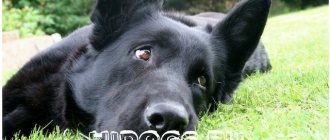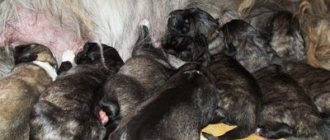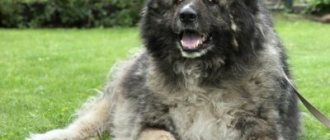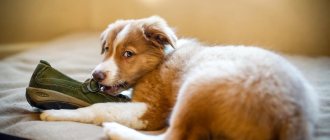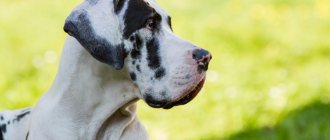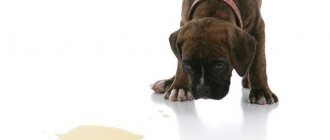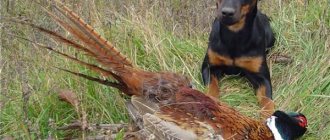Origin of the word shepherd
According to the etymological dictionary, “shepherd” has the same root as the word “sheep.” Shepherd dogs were the dogs that guarded the sheepfold. Schäferhund is translated from German as sheep dog or shepherd dog, which means “flock guard dog.” Thus, the etymology of the word is related to the activity of the animal. The territory of Germany was covered with lush pastures where herds grazed. The word “shepherd dogs” came from someone’s light hand.
A mention of these animals was found in the 7th century. The code of laws of the West German Alemannic tribes provided for punishment for the killing of a shepherd dog.
Where was this breed developed?
In the 18th century Cattle breeding developed rapidly in Germany. There was a need for powerful dogs that could manage a flock. Four-legged shepherds were highly valued. A tendency has emerged to breed dogs with specified performance characteristics. Few people paid attention to the appearance of the animals. The dogs varied greatly in appearance.
Reproduction was placed on a commercial basis; no special standards were put forward. However, two centers for breeding shepherd dogs appeared: Thuringia and Württemberg. These were the names of the most famous kennels, but dogs were bred throughout the German lands. The dogs from the two centers differed in appearance. Thuringian Shepherds had:
- average height;
- wolf color;
- ring tail;
- pointy ears.
Lively, active dogs seemed more attractive compared to the dogs from Württemberg. The latter were more balanced. Dogs of impressive size, with colored spots on their bodies, could have drooping ears. Despite the difference, the owners mated their pets by infusing them with the blood of foreign dogs.
German Shepherd breed standard
Like any breed, shepherds have a certain standard, which indicates the purebred of the animal. The German Shepherd standard includes both a description of appearance and character.
Outwardly, these dogs look neither light nor heavy. They have a strong build. They are distinguished by their roastiness and leanness. A male German Shepherd reaches 600–650 mm at the withers. Bitches are slightly smaller: their height at the withers is 550–600 mm.
As you can see, the height at the withers can vary within a small range. Naturally, such growth is typical for adult animals. However, puppies grow up quite quickly. Therefore, their growth soon reaches the breed standard.
Similar article: How long do German Shepherds live at home?
If you cross a shepherd with other breeds, the dogs will be less tall than normal. Typically, these puppies are small compared to purebreds. Very small dogs are obtained when shepherds are mated with representatives of small breeds.
The German Shepherd has the following breed description:
- the head is elongated, moderately widened and tapering towards the nose. The muzzle and skull have the same proportions. The skull itself is almost square;
- the jaws are well developed. They are powerful. German Shepherds have a scissor bite;
- the tip of the nose is black. This is part of the breed's characteristics;
- lips are dark. They fit tightly to the jaw;
- the eyes are also dark. They are medium in size and almond-shaped. They are characterized by a slightly oblique arrangement; ears are triangular in shape. They are standing and have medium dimensions. Their ends are slightly pointed;
- the neck is powerful, without dewlap;
- the body is stretched. It slopes slightly towards the croup;
- the back is strong and muscular;
- the sternum is well developed;
- the tail hangs down and has a curve. It is characterized by fluffiness on the inside;
- straight and parallel limbs. Paws are rounded.
The coat is hard and lies tightly to the skin. Dogs have an undercoat. The hair is longest on the neck. The color of animals can be gray, brown or black. It is possible to combine colors and form a pattern (the so-called “mask and cloak”). Of course, it is the multi-colored dogs with patterns that are the most recognizable representatives of this breed. However, you should still know what a German Shepherd looks like in order to determine the breed regardless of its color.
We recommend this article:
What are the characteristics of a black German Shepherd?
An adult male weighs approximately 35–40 kg, and a female weighs 25–32 kg. The height of animals is not tied to weight.
This is the breed standard. It should be detected in any purebred dog belonging to this variety. But that's not all. After all, the German Shepherd in its characteristics of the breed also contains a description of its character, on which the characteristics of education and care depend.
We recommend this article:
Genetics and groups of the long-haired German Shepherd
Max von Stephanitz
The history of the German Shepherd begins in 1899, when retired officer Max von Stefanitz met a dog that combined all the perfection of the breed. Max bought the dog and named him Horand von Grafarth. This dog marked the beginning of the breeding work of the main German Shepherd community.
Max von Stefanitz received his veterinary education. Since childhood, he remembered dogs on vast pastures. He dreamed of breeding the ideal dog - the true embodiment of four-legged shepherds. His biography included an unexpected resignation, but it was this that gave him the opportunity to seriously engage in breeding work. He approached the matter in detail and created the Union of German Shepherd Owners. He was the first who did not seek commercial benefits from breeding shepherd dogs.
The purchased dog was phenomenal not only in appearance. Von Stefanitz was engaged in breeding elite dogs sparing no effort:
- selected bitches to match the main sire;
- traveled around the country looking for material;
- worked with nursery owners, explaining the intricacies of breeding selection.
After 100 years, the Union has become the most impressive organization among similar societies. The standards put forward by Max have gone down in history as benchmarks.
Description of the breed
German Shepherds are gorgeous, beautiful dogs with a reliable and obedient disposition. There are two varieties of the breed: long-haired (black, cream, zone colors) and short-haired (black and white colors).
A very proportionate, muscular dog, not massive or heavy, but without the slightest sign of lightness or weakness of build. The body is stretched, with strong bones, covered with powerful muscles; at first glance it is clear that the dog is hardy, agile and capable of lightning-fast throws. The stroke should be elastic, smooth, as if creeping, the body moves forward with a minimum of vertical vibrations, movements are free, without the slightest stiffness.
- The height of a male at the withers is ideally 62.5 cm, the height of a female at the withers is 57.5 cm.
- The head of the German Shepherd is wedge-shaped, dry, and not too wide between the ears.
- The ears are medium-sized, erect, tapering towards the ends. The shells of the ears are open forward. The ears should be parallel and held upright. If the ears lay back at rest or when moving, this is not considered a fault. But if the ears are half erect and always droop, this is a defect.
- The eyes are almond-shaped, not protruding, of medium size, set slightly obliquely. Color - as dark as possible. Light eyes and piercing gaze are undesirable.
- The nose of the German Shepherd is distinguished by a straight back, without humps or deflections. The nose is only black.
- The bite of the German Shepherd is scissor-shaped, full (42 teeth). The jaws are strongly developed, the teeth are firmly held in the alveoli.
- The body of these dogs is distinguished by a solid top line from the neck through the withers and back to the sloping (about 23° to the horizon) croup. The loin of German Shepherds is muscular and wide, the croup is long and imperceptibly merges with the base of the tail.
- The chest is moderately wide, with a well developed lower part and a long sternum.
- The back of a German Shepherd is muscular, strong, strong.
- The front limbs of the German Shepherd are straight and parallel when viewed from the front. The elbows should not be turned inward or outward, neither in motion nor at rest. The paws are rounded, the toes are arched (in a ball). The pads are durable, not brittle and without cracks. The claws are dark and strong.
- The hind legs are slightly set back and parallel when viewed from behind. The length of the thigh is approximately equal to the length of the tibia, the angle between them is about 120⁰. The feet are slightly arched, compact, and the pads are hard and dark in color, as are the strong nails.
- The tail should reach the hock joint, but not go beyond the middle of the metatarsus. The tail hangs in a soft curve and is raised when moving (not higher than the horizontal line). Surgical correction of the tail is not permitted.
The coat of the German Shepherd consists of coarse, thick, straight, outer coat and undercoat that fits tightly to the body. The hair is shorter on the head, the inner surface of the ear, on the paws and toes, and on the front surface of the limbs. On the neck, on the contrary, the hair is longer and more abundant. On the back of the thighs, the longer coat forms the breeches (moderate).
+
Color: Black with red-brown, brown, yellow to light gray markings. Black and gray are plain, gray ones have a darker tint. With a black cloak and mask. Inconspicuous small white markings on the chest and very light undersides are acceptable but not desirable. The nose of all colors must be black. The absence of a mask, piercingly light eyes, as well as light to white markings on the chest and inner sides, light claws and a red tip of the tail should be assessed as weak pigment. The undercoat has a light gray tone. White color is not acceptable.
We advise you to read: Alabai Dog Breed
How a shepherd became a service dog
For a long time, a person interacted with a German shepherd only as a shepherd. However, the 19th century became a time of industrialization. The number of pastures was rapidly declining, and the need for flock guards was decreasing.
In 1901, von Stephanitz became the permanent president of the Union. He actively promoted German Shepherds for military and civilian service. The police began to use dogs, and they found a place in the army. This became possible due to the fact that during selection a serious emphasis was placed on the behavioral characteristics of the dogs. The President of the Union opened special competitions for shepherd dogs to secure the status of service dogs with the issuance of awards.
Character and training of the German Shepherd
The peculiarity of the breed is its versatility, ease of maintenance, as well as high intelligence, which allows them to be effectively trained.
Similar article: When the ears of a German Shepherd stand up and the reasons for improper landing
Each German Shepherd has an individual character. These animals are self-confident, persistent and brave. They love to demonstrate their skills and therefore are always on the move. Shepherd dogs obey their owners and are infinitely loyal to them. It is best for one person to raise them. They are also good with children.
Animals are highly trainable. You can raise puppies as young as 2 months old.
As already noted, an important distinguishing characteristic of the German Shepherd is high intelligence. Thanks to their intelligence, these dogs have a wide variety of uses today.
We recommend this article:
Weight and height of a German Shepherd puppy by month
Crisis in breeding and a new stage in the history of the origin of the German Shepherd
Thanks to the Union, the breed achieved recognition and spread beyond the country. Unscrupulous owners took advantage of the interest in the dog and deviated from the rules for profit. The blood of defective dogs of non-standard sizes with unstable temperament was poured into the breed. Large dogs were in particular demand.
In the name of saving the line, in 1925 the “Union” held a conference that united the breeders in the desire to return standards. A sample of Champions from different years was taken, of which the best performance was from a male named Claudo von Boxberg. The main genetic branches originated from it. The appearance of this dog marked the boundary between past and future standards. A male chosen among the elite means no less for the development of the line than the legendary Horand.
Why the German Shepherd was bred for “sports” breeding
In 1960, selection was carried out quite actively. Training competitions came into fashion and were gaining popularity all over the world. Such competitions required special dogs. The emphasis was on tirelessness, speed and excitement: the exterior did not play a special role.
Since breeders of “sporting” dogs appeared, the society decided to distinguish 2 breed branches: elite dogs and working dogs. For elite breeding animals, checks were required for:
- absence of physical abnormalities;
- resistance to loads;
- equilibrium;
- exterior;
- correspondence to origin.
The latter is verified by DNA analysis. The value of sporting dogs was marked by the number of victories in competitions; they did not need beauty.
Caring for a German Shepherd
A German Shepherd only needs to be brushed about twice a week. If the German Shepherd's coat is not regularly groomed, there will be a lot of short, dark hair in the house, and their undercoat, especially on the belly and neck, will become matted. Find a brush that removes hair well and that your dog likes.
Sometimes you can trim the long hair on your dog's back legs to keep it from tangling.
It is better to bathe German Shepherds not often, once or twice a year. Frequent bathing can cause the coat to lose its natural oils and become dull. When bathing, it is very effective to use a brush, which will help rid your dog of a lot of excess hair after bathing.
At the age of 1.5 months, the puppy tries to chew everything it comes across. Make sure that the baby has no way to get to electrical and telephone wires, as well as to room slippers. The puppy should not play with shoes under any circumstances, otherwise, when he grows up, they will constantly suffer from his teeth. Do not let your pet chew on rubber objects, as he may swallow the bitten pieces, which can have serious consequences. There are many known cases where such moments led to the death of puppies.
Sometimes your puppy may start chewing on legs or other wooden parts of furniture. In this case, you can give him dried pig ears or a piece of a thick linden branch, dipping it in natural wood glue and drying it. It is also useful to give your baby carrots or apples as toys: he will not only satisfy his innate need to chew, but will also receive a small portion of vitamins.
We advise you to read: Shiba Inu dog breed
During the teething period, prepare special toys for your baby that he can play with for a long time. For example, cast rubber balls, calcined pure brain bones, or specially made imitations of them.
The German Shepherd is distinguished by its long development: the dog becomes fully mature by the age of three. The puppy grows quickly and appears to be an adult dog, but requires careful handling. When playing games, do not take away a toy or ball from him, so as not to spoil his bite or damage his teeth. Do not pet the puppy on the head and ears: the ear cartilages are still weak, and the ears may not take the desired standing position.
German Shepherds are strong and athletic dogs and require significant exercise. A large running yard and daily walks keep German Shepherds in good physical shape. Their intelligence requires constant mental stress, so training for such dogs is really necessary. In addition, it provides them with sufficient physical activity.
The German Shepherd is very suitable for people who love sports and lead an active lifestyle. She is quite capable of hiking in the forest or in the mountains, jogging for many kilometers next to you, and even behind a bicycle. The latter, by the way, is a very good way to train a German Shepherd. The main thing is not to overload your pet in hot weather and begin such training no earlier than the puppy turns one year old.
New requirements for Breed Champions
In the 80s A high-level professional, Herman Martin, came to the post of President of the Union. Along with it came new requirements for the championship title. Now it was impossible to get a championship by visiting the exposition. In addition to the basic requirements, the dog had to:
- participate in shows more than once;
- regularly withstand expert tests;
- give worthy offspring.
Why was multi-year selection necessary? This excluded random animals from entering the elite group, since the status was confirmed many times.
In what year did German shepherds appear in Russia?
The breed appeared in Russia not by chance. German Shepherds were brought in in 1904 as potential ambulance dogs. They distinguished themselves during the Russo-Japanese War. In 1908, the animals took part in police dog competitions along with Doberman Pins.
German Shepherds in the USSR
After the revolution in 1924, a large batch of representatives of the breed were brought to the USSR for the needs of the NKVD and border troops. The project was not very successful, since it coincided with the canine crisis of the 20s. Animals that fall outside the breeding standards have entered the country. They had defects in their exterior and could be angry or cowardly, which German dog handlers did not allow. The lack of competent breeders, unsystematic crossing and poor material did not allow the breeding of dogs of Western standards.
How did the Great Patriotic War influence the development of the breed in Russia?
After the war, an order was received to breed dogs for use in the Soviet Army. However, during this period, the homeland of the German Shepherd was closed to Soviet dog handlers, so it was necessary to work with the remaining dogs and dogs left by the Germans during the retreat, and it’s hard to even imagine what kind of animals could be found in the “ruins” of the terrible war.
In addition to the lack of worthy samples, there were also difficulties:
- negative attitude of people towards the definition of “German”;
- the role of dogs in guarding concentration camps and punitive squads.
In 1946, the breed was named the East European Shepherd to break away from bad associations. The lack of business contacts with the Germans caused damage to selection: the breed was bred deviating from European standards.
Golden rules for German Shepherd breeders
1. Breed this breed
out of love for her, for your own joy and comfort, but never
for profit
, since then you are greatly mistaken in your calculations. Strive to ensure that your pets and their young are near you as often and as long as possible, work with them as much as possible, give them more freedom and movement, cultivate and monitor their physical and mental development. Only completely healthy shepherd dogs with strong nerves are suitable for breeding. Your dog will only become a real German Shepherd, needed for our service and guard purposes, if it is tolerant not only in its environment, in the circle of your family, but also when it is closely united with you in soul, then you will experience complete and true joy and you will gain a real right and grounds for a promising kennel and for the correct and beneficial use of your dog and work with it.
2. Always remember that breeding a German Shepherd should be the breeding of an exclusively socially useful dog, and let only this task always stand before your eyes: a dog with good inclinations, with a perfect body and a desire to work.
3. Strive for the highest improvement of the breed - do not chase a large litter at the expense of the health and vitality of your breeding specimens and their breed, always remember about the future, and not about your personal benefits.
4. We must strive to breed not “winners” and “champions”, but dogs to raise the average level of the breed, to equalize, consolidate and improve good qualities, smooth out or completely eliminate shortcomings. Since they do not admit the dog for breeding purposes, it is not at all necessary to use every dog for breeding, but only those recognized as suitable for this purpose. Therefore, it is necessary to breed only with selected producers.
5. Dogs originating from the mass breeding of kennels and city factories are not suitable as factory specimens. Choose a bitch - the basis of your future breeding ground - from a strong, healthy, well-working and already trained breed and select the appropriate male for mating with her. Show champions and winners are not always the best and most reliable producers, especially bitches. Selection gives a great guarantee.
6. When making a breeding pair, you need to take into account blood, general health, exterior, character, training, i.e. training and adaptability to work, while the dog should not be your property at all. Weak-hearted and cowardly dogs are not suitable for breeding, as well as those who have suffered serious illnesses (plague, rickets), since painful inclinations are inherited. Healthy, well-kept dogs have good healthy jaws, a well-fitting coat, clear, clean eyes and a lively, cheerful character and disposition.
7. Breed only good blooded dogs, but don't get too carried away with inbreeding. It is quite enough if the producers have relatives in the fourth or fifth generation. Leave a closer family connection to a sophisticated breeder, who can judge whether to expect from such a relationship the strengthening of the desirable qualities of both producers or, on the contrary, the shortcomings hidden in the blood and implicitly expressed in these producers. If you yourself are not yet sufficiently informed and are not sure about the choice of blood and sire, contact your breeding manager.
8. Pay attention to whether sexual characteristics
of your breeders: bitch-like males or male-like females are not suitable for breeding. Both in height and in bone structure, both producers must suit each other. Specimens deviating from the average size (standard - 60-65 cm for a male and 55-60 cm for a female) are unsuitable producers. Do not breed with dogs that are too old or too young. Males are suitable for breeding purposes only after reaching a full two years of age, by which time they have fully developed. The bitch can be used only a few months earlier. In males, by the end of the eighth year, and in females a little earlier, in most cases the ability to reproduce decreases. First of all, don't chase a champion just because he has racked up prizes. The champion was the best only at this show, but this still does not mean that he is the best for breeding, and an even bigger question is whether he is a suitable partner for this bitch.
9. For your bitch, look in advance and select a suitable male
, but not when the heat has already begun. Also ask the owner of the male dog in advance for his consent to provide him for breeding. Agree in writing in advance, strictly observe the terms worked out and pay honestly: cheating does not mean being dishonest.
10. Follow
carefully
monitor the onset of heat
and the bitch herself, protect her during the entire time of heat, both before and after mating, from being covered by another male. An old Arabic proverb says: “It is a thousand times more difficult to protect and monitor a willing bitch than a whole bag of fleas.” Accidental, unwanted, erroneous matings are always possible in a willing bitch. If such a disaster has happened, nothing will help, but mating will not harm further litters. First of all, don’t try to hide such an accident. Our breeding is based on complete mutual understanding and trust, and therefore try not to let the trust in you be shaken. If your blood bitch was mated with a male of another breed, then her litter should be considered not purebred. Carefully keep a book of your nursery, in which you carefully record all incidents in it. Subsequently, you will learn a lot of useful things from it.
11. Don't delay mating for too long
hoping for a larger number of males in the litter is a prejudice, which usually results in weaker puppies, and besides, the perception of the semen may have already passed. Besides, we also need good bitches. Cover your bitch only if she is absolutely healthy and there is no plague or other contagious diseases in your kennel. Regardless of everything, make sure that your bitch does not have vaginal diseases, for which you invite a veterinary specialist. A one-time coating is sufficient.
12. Weak
and
never
cover
bitch - hold her back. A strong and well-built healthy bitch can be bred every time she is in heat, that is, twice a year, but then she must be especially protected during whelping. Retired bitches are prone to obesity, and obese dogs are unsuitable for breeding, since they often end up single when breeding.
13. A bitch’s pregnancy is noticeable only in the fifth week, and therefore watch her, give her plenty of movement, but do not overtire her, do not allow her to make any sudden movements or jumps, chase like crazy, etc. Feed her well and nourishingly. Give him plenty of meat and oatmeal, not liquid oatmeal, gradually accustom him to large portions of dairy products, do not forget to add mineral supplements with calcium and phosphorus, but do not overfeed. Divide its daily portion into 3-4 parts, in order to avoid burdening the stomach and aggravating the back, which is already burdened with pregnant offspring. Before coating, give an anthelmintic on the advice of a specialist, and not a “homemade” one. Don't overlook grooming. By the time of whelping, the bitch should be completely free from insects and parasites. As a rule, a bitch whelps on the 62nd day.
14. For whelping
It is best to use a box with bedding and place it in a dry place without drafts. A seasoned bitch whelps freely in a well-maintained outdoor kennel, even in winter. Raising a seasoned litter is much better than raising weak, puny little ones. Train the bitch in advance to her whelping bed.
15. Don't disturb the bitch during whelping
, it’s best to leave her to herself, in most cases everything works out well. As a last resort, call a veterinarian. Unconditionally remove all strangers, all other animals. A few hours after whelping, or the next morning, the bitch that gave birth must be taken out into the yard so that she can recover, and at this time inspect the litter yourself. Weak or unsuccessful puppies must be destroyed immediately, as well as excess ones. A healthy, strong bitch who whelps once a year should not be given more than five to six puppies, a bitch who is in heat every time should not be given more than four to five puppies, while it is best to leave two to three puppies for first-time mothers. If there is no nurse at hand, the remaining puppies need to be culled and destroyed, but so that the bitch does not notice this. The nurse must be prepared and adjusted in advance to give her the opportunity to get used to the new environment. It is necessary that she whelps at approximately the same time as your bitch, but puppies must receive their first milk from their mother. It happens that nurse-fed puppies turn out unsuccessful, although such cases are rare, not to mention artificially fed ones, which are almost always unsuccessful. Therefore, under no circumstances should you try to feed the litter artificially if you do not have a suitable nurse. Of course, you and your family do not have as much free time as you need to spend on artificial feeding of puppies. At best, the puppies will emerge weak, frail, and easily susceptible to all sorts of diseases. Large litters left to the mother are also very easily susceptible to disease, since even a strong and healthy bitch will not be able to properly feed it. Show the litter to a specialist and ask him for the necessary advice.
16. While the bitch is nursing puppies, feed her as much as she can: meat, oatmeal, oatmeal soups, whole milk - all with the addition of mineral supplements. Never make sudden changes in diet, inspect the bitch's udder daily and monitor her stomach. While the bitch is nursing, she herself takes care of the cleanliness of her nest, but then the breeder must take on this responsibility. Cleanliness of both the nest itself and the bitch and puppies is necessary to avoid the appearance of parasites. If they get started, it’s a disaster: the puppies weaken and lag behind in growth and development and become easily susceptible to all kinds of diseases. In addition, cleanliness is necessary to protect puppies from worms: make sure that the bitch does not rest in the room where the puppies are. Soon after birth, it is necessary to cut off the dewclaws on the puppies' hind legs, if any, with scissors.
17. If the bitch is milky
begins to subside, you can start feeding the puppies raw meat from the end of the third week, but it is better to wait until the fifth week. In addition to meat, in the future, feed with liquid oatmeal soup or meat broth. While the bitch is breastfeeding herself, do not give the puppies any other milk. By the end of the sixth week, the puppies need to be separated and fed 5-6 times a day, and the bitch should be allowed in only at night, and then not allowed at all. Gradually increase the portions of meat, introduce him to cow's or goat's milk, and add mineral supplements all the time. Puppies raised in this way, accustomed to independence, will be very strong by the end of the seventh week, and by the end of the eighth week they can already be distributed. During the last days before the puppies are completely separated from the bitch, she should be fed as little as possible, her teats should be washed with vinegar water and she should be given as much exercise as possible in the air.
18. If, with such care, the entire litter
or a single specimen
is developing poorly
(it is necessary to weigh all puppies regularly), the coat is not smooth, or the puppy is lethargic, whines a lot, is tired - call a veterinarian. Perhaps the puppies are suffering from worms; If the litter develops strong, it is necessary to wait with anthelmintics and let the puppies grow up. Do not use any of your own remedies; only a doctor can provide proper treatment. When the puppies begin to climb out of the nest on their own, give them this opportunity completely - air, light, sun, games and movement are very useful for them, for them this is everything. Provide compacted and dry running ground so they can frolic freely. For rest, set aside a place not in the direct sun, teach them to eat regularly, to be clean, and after the puppies eat, take them out to the grass to grow. In any case, by your treatment of the puppies and your trust in them, evoke their love and trust in you, by doing this you will lay the foundation for the useful German Shepherd you need.
by Max von Stefanitz
when using materials
link to resource
required
News edited by: maugli
— 26-03-2020, 16:51

